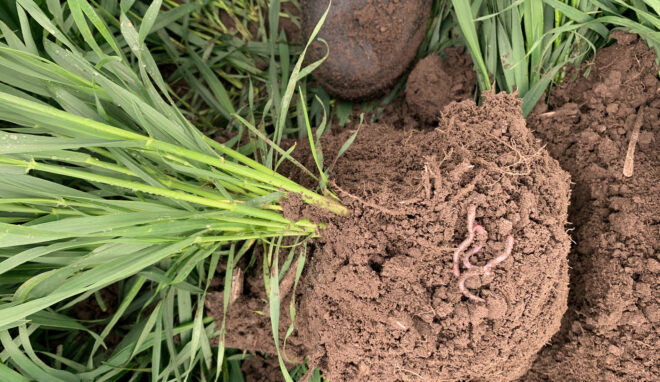In Südergellersen in the north of Germany, brothers Henning and Arne Beecken work 400ha with their parents and four employees. The crop rotation in their sixth-generation family farm includes 60ha of potatoes and 35ha of sugar beet while the rest is reserved for cereals, notably hybrid rye. Seed production is the spearhead of the operation. The soil is sandy with some wet zones: All of the land is irrigated and 30% is drained.
When they got set up, the two brothers convinced their parents to put the farm on a new track. The clincher was working on other farms which had soils with more organic matter. “We have changed the system in the past three years,” says Henning, highlighting that the main focus here is on significantly reducing tillage.
The lowest possible harvest losses
The seed contract now requires two years of root crops before a grain crop where before it was possible to have consecutive cereal crops. “Because we now have more root crops, we have reduced tillage by 70%.” The brothers do not follow a fixed rotation, but instead adapt to individual fields year after year.

Arne Beecken at manure acceptence point with Harvest Lab sensor.
A rather complex system: To comply with the two years root crop prior to a cereal crop rotation as required in the new seed contract, the Beeckens must exchange several hundred hectares with their neighbors, depending on the year. “We treat these fields as if they were ours,” emphasizes Henning.
Deep tillage is normally required before sowing the grain crop. To forego this process after harvest, the family opted to invest in technology to prevent possible regrowth: A high-tech combine “that would be able to cover another 1,000ha, but which allows us to thresh at very little loss, below 0.5%. Otherwise, the grains that we leave in the field will annoy us again the next time a grain crop is planted,” says Henning.
Because of our specialisation, we try to find a balance and make compromises.
Arne Beecken
Another avenue is optimising mulch tilling. “We are now asking ourselves: Is it always necessary to change the discs to five centimetres? We have also started using a spiked harrow.” But three mulch tillage passes are often necessary to germinate as many seeds as possible. “Of course, it’s bad for water and humus retention, but we don’t use less than three. We make money from our seeds.”
Drastic reduction of mineral fertiliser
Lastly, the farm has completely rethought its approach to fertiliser by increasing its organic intake. The 620 pigs raised here would not be enough to fulfil the nutritional needs of the 400ha. “We originally wanted to work with a manure exchange, but it quickly became clear to us that we needed a permanent partner. Therefore, we have initiated a partnership with a farm where we take the digestate from their biogas operation,” says Henning. “For this reason, we have invested in a covered 6,000m3 silo.” Every day a truck drives into the yard with a load of digestate. During the intake the nutrient content is measured by an integrated NIR sensor. “We have to be clear about the ingredients. You are practically dealing with a living substance. That needs to be analyzed.” The family expects that the investment pays off within ten years.
The first application is done behind a chisel plough with hanging pipes, so the liquid manure is covered by soil immediately after spreading. For fertilising the grain crops in spring, a 12m disc injector is used, and a 1m section control unit avoids excess application. The land is not classified as a water vulnerable zone, however the most precise calculation for the crop requirements and soil parameters is the name of the game here. Ultimately, mineral fertiliser use was reduced by 80%.
Cover crops have also been introduced, always before the root and rye crops. “We no longer leave the fields bare in winter. It’s an outdated approach,” says Arne. The farm uses a ‘greening’ mix, which cannot contain too many leguminous crops if spreading organic manure afterwards. Oats are limited because of the risk of seed contamination. “Cover crops create a good soil structure and transform the nutrients in the soil into biomass,” summarises Henning. “We fertilise the crops to obtain good rooting.
Signs of a more vibrant soil
“The ground starts to smell like soil again when you put a spade to it,” smiles Henning. “Not just as a substrate, but like living soil.” In areas where the soil is not tilled for three years, water retention improves significantly. “This is another benefit of cover crops, as their rooting improves the soil’s capillary action.
“Because of our specialisation we try to find a balance, to make compromises,” says Arne. “If we weren’t producing seed, we would certainly use the no-till system and direct sowing, if possible,” adds his brother. “But it would be tricky to set up direct sowing with the potato harvester sifting through the entire topsoil every four to six years.” Even so, it’s obvious that the organic matter content has increased. “Until three years ago, you wouldn’t have seen a single earthworm. But they’re back and every now and then we see a bird catch one which is rewarding.”
For us, this is a generational project.
Arne und Henning Becken
The family expects a 10-year return on the investment made. A decisive point is the nitrogen fertiliser costs, which have fallen by 80%. The environmental balance has not been calculated, but the indicators are there: A decrease in mineral fertiliser usage and, of course, increased organic matter.
Read how Alain Duphil increases his humus content by storing CO2:
Field crops are gaining recognition because of the important climate benefit they offer: Storing carbon in the soil by increasing its organic matter content. This creates new expectations of agriculture, but also new opportunities. Visit to a French farmer who markets his CO₂ storage.




